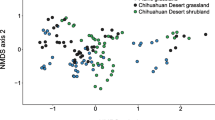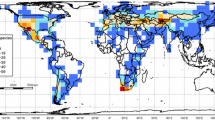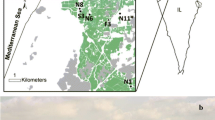Abstract
Native bee diversity is poorly documented for many regions of the globe, particularly in the Neotropics. The available structured inventories in this biogeographical region provide reliable data, but they lack a comprehensive interpretation due to the absence of an effort to relate diversity and composition data with environmental variables. We aimed to answer the following questions: (1) Do abiotic factors explain variations in the richness, diversity, and composition of bee assemblages? (2) If so, which abiotic factors explain each of these community descriptors? We used a database comprising 33 systematic surveys of bee assemblages along eastern Neotropics. We found significant effect of abiotic variables on biotic diversity parameters and assemblage composition. Temperature annual range was the main abiotic predictor affecting bee richness and diversity, while composition was explained by annual mean temperature, temperature seasonality, temperature annual range, and by annual precipitation.






Similar content being viewed by others

References
Abrahamczyk, S., Gottleuber, P., Matauschek, C., Kessler, M. (2011) Diversity and community composition of euglossine bee assemblages (Hymenoptera: Apidae) in western Amazonia. Biodivers. Conserv. 20, 2981–3001
Aguiar, A.J.C., Martins, C.F. (2003) The bee diversity of the Tabuleiro vegetation in the Guaribas Biological Reserve (Mamanguape, Paraíba, Brazil). In: Melo, G.A.R., Alves-dos-Santos, I. (eds.) Apoidea Neotropica: Homenagem aos 90 Anos de Jesus Santiago Moure, pp. 209–216. Editora UNESC, Criciúma
Aguiar, A.J.C., Melo, G.A.R. (2008) Biogeografia de áreas abertas da América do Sul, com ênfase em abelhas da tribo Tapinotaspidini (Hymenoptera, Apidae). In: de Jong, D., Francoy, T.M., Santana, W.C. (eds.) Anais do VIII Encontro sobre Abelhas, pp. 218–223. FUNPEC, Ribeirão Preto
Aguiar, C.M.L., Martins, C.F. (1997) Abundância relativa, diversidade e fenologia de abelhas (Hymenoptera, Apoidea) na caatinga, São João do Cariri, Paraíba. Brasil. Iheringia Ser. Zool. 83, 151–163
Aguiar, C.M.L., Zanella, F.C.V. (2005) Estrutura da comunidade de abelhas (Hymenoptera: Apoidea: Apiformis) de uma área na margem do domínio da caatinga (Itatim, BA). Neotrop. Entomol. 34, 15–24
Albuquerque, P.M.C., Ferreira, R.G., Rêgo, M.M.C., Santos, C.S., Brito, C.M.S. (2001) Levantamento da fauna de abelhas silvestres (Hymenoptera: Apoidea) na região da “Baixada Maranhense”: Vitória do Mearim, MA, Brasil. Acta Amaz. 31, 419–430
Almeida, M.C. (2003) Taxonomia e biocenótica de Apoidea (Hymenoptera) de áreas restritas de cerrado no município de Jaguariaíva, Paraná, sul do Brasil. PhD thesis, Universidade Federal do Paraná, Curitiba.
Barbola, I.F. (2000) Biocenótica de Apoidea (Hymenoptera) de uma área restrita da Floresta Atlântica, Morretes, Paraná, Brasil, e aspectos da ecologia da polinização de Stachytarpheta maximiliani (Verbenaceae). PhD thesis, Universidade Federal do Paraná, Curitiba.
Barbola, I.F., Laroca, S. (1993) A comunidade de Apoidea (Hymenoptera) da Reserva Passa Dois (Lapa, Paraná, Brasil): 1. Diversidade, abundância relativa e atividade sazonal. Acta Biol. Par. 22, 91–113
Biesmeijer, J.C., Slaa, E.J., de Castro, M.S., Viana, B.F., Kleinert, A.M.P., Imperatriz-Fonseca, V.L. (2005) Connectance of Brazilian social bee: food plant networks is influenced by habitat, but not by latitude, altitude or network size. Biota Neotrop. 5, 85–93
Biesmeijer, J.C., Roberts, S.P.M., Reemer, M., Oholemuller, R., Edwards, M., et al. (2006) Parallel declines in pollinators and insect-pollinated plants in Britain and the Netherlands. Science 313, 351–354
Biesmeijer, J.C., Slaa, E.J. (2006) The structure of eusocial bee assemblages in Brazil. Apidologie 37, 240–258
Boaventura, M.C. (1998) Sazonalidade e estrutura de uma comunidade de abelhas silvestres (Hymenoptera, Apoidea) numa área de cerrado do Jardim Botânico de Brasília, Distrito Federal. MSc thesis, Universidade de Brasília, Brasília.
Bortoli, C., Laroca, S. (1997) Melissocenologia no Terceiro Planalto Paranaense. I: Abundância relativa das abelhas silvestres em um biótopo urbano de Guarapuava (PR, Brasil). Acta Biol. Par. 26, 51–86
Burnham, K.P., Anderson, D.R. (2002) Model selection and multimodel inference: a practical information-theoretic approach. Springer, New York
Camargo, J.M.F. (1994) Biogeografia de Meliponini (Hymenoptera, Apidae, Apinae): a fauna Amazônica. In: Garófalo, C.A. (ed.) Anais do II Encontro sobre Abelhas, pp. 46–59. FFCLRP/USP, Ribeirão Preto
Cardoso, C.F., Silveira, F.A. (2012) Nesting biology of two species of Megachile (Moureapis) (Hymenoptera: Megachilidae) in a semideciduous forest reserve in southeastern Brazil. Apidologie 43, 71–81
Cassemiro, F.A.S., Barreto, B.S., Rangel, T.F.L.V.B., Diniz-Filho, J.A.F. (2007) Non-stationarity, diversity gradients and the metabolic theory of ecology. Global Ecol. Biogeogr. 16, 820–822
Chesson, P. (2000) Mechanisms of maintenance of species diversity. Annu. Rev. Ecol. Syst. 31, 343–366
Clarke, K.R., Warwick, R.M. (2001) Change in marine communities. An approach to statistical analysis and interpretation. Primer-E, Plymouth
Cure, J.R., Bastos, G.S.B., Oliveira, M.J.F., Souza, O.F. (1991) Influência do tamanho da amostra na estimativa da riqueza em espécies em levantamentos de abelhas silvestres (Hymenoptera, Apoidea). Rev. Bras. Zool. 7, 101–110
Diniz-Filho, J.A.F., Bini, L.M., Hawkins, B.A. (2003) Spatial autocorrelation and red herrings in geographical ecology. Global Ecol. Biogeogr. 12, 53–64
Ebeling, A., Klein, A.-M., Tscharntke, T. (2011) Plant–flower visitor interaction webs: temporal stability and pollinator specialization increases along an experimental plant diversity gradient. Basic Appl. Ecol. 12, 300–309
Faria-Mucci, G.M., Camargo, J.M.F. (1996) A flora melitófila e a fauna de Apoidea em um ecossistema de campos rupestres, Serra do Cipó, Minas Gerais, Brasil. In: Garófalo, C.A. (ed.) Anais do II Encontro sobre Abelhas, pp. 217–224. FFCLRP/USP, Ribeirão Preto
Faria-Mucci, G.M., Melo, G.A.R., Campos, L.A.O. (2003) A fauna de abelhas (Hymenoptera, Apoidea) e plantas utilizadas como fonte de recursos florais, em um ecossistema de campos rupestres em Lavras Novas, Minas Gerais, Brasil. In: Melo, G.A.R., Alves-dos-Santos, I. (eds.) Apoidea Neotropica: Homenagem aos 90 Anos de Jesus Santiago Moure, pp. 241–256. Editora UNESC, Criciúma
Gaston, K.J. (2000) Global patterns in biodiversity. Nature 405, 220–227
Gonçalves, R.B., Brandão, C.R.F. (2008) Diversidade de abelhas (Hymenoptera, Apidae) ao longo de um gradiente latitudinal na Mata Atlântica. Biota Neotrop. 8, 51–61
Gonçalves, R.B., Melo, G.A.R. (2005) A comunidade de abelhas (Hymenoptera, Apidae s.l.) em uma área restrita de campo natural no Parque Estadual de Vila Velha, Paraná: diversidade, fenologia e fontes florais de alimento. Rev. Bras. Entomol. 49, 557–571
Gonçalves, R.B., Melo, G.A.R., Aguiar, A.J.C. (2009) A assembléia de abelhas de uma area restrita de campos naturais do Parque Estadual de Vila Velha. Paraná e comparações com áreas de campos e cerrado. Pap. Avulsos Zool. 49, 163–181
Gotelli N.J., Entsminger G.L. (2004) EcoSim: Null models software for ecology. Version 7. Acquired Intelligence Inc. and Kesey-Bear. Burlington.
Grundel, R., Jean, R.P., Frohnapple, K.T., Glowacki, G.A., Scott, P.E., Pavlovic, N.B. (2010) Floral and nesting resources, habitat structure, and fire influence bee distribution across and open-forest gradient. Ecol. Appl. 20, 1678–1692
Hammer, O., Harper, D.A.T., Ryan, P.D. (2001) PAST: Paleontological statistics software package for education and data analysis. Palaeontol. Electron. 4, 1–9
Hijmans, R.J., Cameron, S.E., Parra, J.L., Jones, P.G., Jarvis, A. (2005) Very high resolution interpolated climate surfaces for global land areas. Int. J. Climatol. 25, 1965–1978
Hildebrand, H. (2004) On the generality of the latitudinal diversity gradient. Am. Nat. 163, 192–211
Hoffmann, M. (1990) Estrutura e importância de uma comunidade de abelhas no Rio Grande do Sul, para a polinização de plantas cultivadas. PhD thesis, Universidade Federal do Paraná, Curitiba.
Hurlbert, S.H. (1971) The non-concept of species diversity: a critique and alternative parameters. Ecology 52, 577–586
Ishihara, M. (1998) Geographic variation in insect developmental period: effect of host plant phenology on the life cycle of the bruchid seed feeder Kytorhinus sharpianus. Entomol. Exp. Appl. 87, 311–319
Jamhour, J., Laroca, S. (2004) Uma comunidade de abelhas silvestres (Hym., Apoidea) de Pato Branco (PR- Brasil): diversidade, fenologia, recursos florais e aspectos biogeográficos. Acta Biol. Par. 33, 27–119
Jarque, C., Bera, A. (1980) Efficient tests for normality, homoscedasticity and serial independence of regression residuals. Econ. Let. 6, 255–259
Jetz, W., Rahbek, C., Lichstein, J.W. (2005) Local and global approaches to spatial data analysis in ecology. Global Ecol. Biogeogr. 14, 97–98
Kamke, R., Zillikens, A., Steiner, J. (2011) Species richness and seasonality of bees (Hymenoptera, Apoidea) in a restinga area in Santa Catarina, southern Brazil. Stud. Neotrop. Fauna Environ. 46, 35–48
Koellner, T., Hersperger, A.M., Wohlgemuth, T. (2004) Rarefaction method for assessing plant diversity on a regional scale. Ecography 27, 532–544
Kosior, A., Celary, W., Olejniczak, P., Fijal, J., Król, W., Solarz, W., Ponka, P. (2007) The decline of bumble bees and cuckoo bees (Hymenoptera: Apidae: Bombini) of western and central Europe. Oryx 41, 79–89
Krug, C., Alves-dos-Santos, I. (2008) O uso de diferentes métodos para amostragem da fauna de abelhas (Hymenoptera: Apoidea), um estudo em Floresta Ombrófila Mista em Santa Catarina. Neotrop. Entomol. 37, 265–278
Laroca, S., Orth, I. (2002) Melissocoenology: historical perspective, methods of sampling, and recommendations. In: Kevan, P.G., Imperatriz-Fonseca, V.L. (eds.) Pollinating bees: the conservation link between agriculture and nature, pp. 217–225. Ministry of Environment, Brasília
Lazaridis, A. (2007) A note regarding the condition number: the case of spurious and latent multicollinearity. Qual. Quant. 41, 123–135
Ludwig, J.A., Reynolds, J.F. (1988) Statistical ecology: a primer on methods and computing. Wiley, New York
Madeira-da-Silva, M.C., Martins, C.F. (2003) Abelhas (Hymenoptera, Apoidea Apiformes) de uma área de restinga, Paraíba, Nordeste do Brasil: abundância, diversidade e sazonalidade. Rev. Nordest. Biol. 17, 75–90
Maia, C.M. (2008) Fauna de abelhas da Reserva Particular do Patrimônio Natural do Rio Cachoeira no município de Antonina, Paraná. MSc thesis, Universidade Federal do Paraná, Curitiba.
Martins, A.C., Melo, G.A.R. (2010) Has the bumblebee Bombus bellicosus gone extinct in the northern portion of its distribution range in Brazil? J. Insect Conserv. 14, 207–210
Martins, C.F. (1990) Estrutura da comunidade de abelhas (Hymenoptera, Apoidea) na Caatinga (Casa Nova, BA) e na Chapada Diamantina (Lençóis, BA). PhD thesis, Universidade de São Paulo, São Paulo.
Martins, C.F. (1994) Comunidade de abelhas (Hym., Apoidea) da caatinga e do cerrado com elementos de campo rupestre do estado da Bahia. Brasil. Rev. Nordest. Biol. 9, 225–257
Martins-Ramos, D., Chaves, C.L., Bortoluzzi, R.L.C., Mantovani, A. (2011) Florística de floresta ombrófila mista altomontana e de campos em Urupema, Santa Catarina. Brasil. Rev. Bras. Bioci. 9, 156–166
Mason, R.L., Gunst, R.F., Hess, J.L. (1989) Statistical design and analysis of experiments: applications to engineering and science. Wiley, New York
Mateus, S. (1998) Abundância relativa, fenologia e visita às flores pelos Apoidea do cerrado da estação Ecológica de Jataí–Luis Antonio–SP. MSc thesis, Faculdade de Filosofia, Ciências e Letras, Universidade de São Paulo, Ribeirão Preto.
Melo, G.A.R. (2007) Introductory Remarks. In: Moure, J.S., Urban, D. and Melo, G.A.R. (eds.) Catalogue of Bees (Hymenoptera, Apoidea) in the Neotropical Region, pp. v–xi. Sociedade Brasileira de Entomologia, Curitiba.
Michener, C.D. (1979) Biogeography of the bees. Ann. Mo. Bot. Gard. 66, 277–347
Michener, C.D. (2007) The bees of the world. The Johns Hopkins University Press, Baltimore
Millet-Pinheiro, P., Schlindwein, C. (2008) Comunidade de abelhas (Hymenoptera, Apoidea) e plantas em uma área do Agreste pernambucano. Brasil. Rev. Bras. Entomol. 52, 625–636
Minchin, P.R. (1987) An evaluation of relative robustness of techniques for ecological ordinations. Vegetatio 69, 89–107
Morato, E.F., Martins, R.P. (2006) An overview of proximate factors affecting the nesting behavior of solitary wasps and bees (Hymenoptera: Aculeata) in preexisting cavities in wood. Neotrop. Entomol. 35, 285–298
Morrone, J.J. (2006) Biogeographic ares ans transition zones of latin America and the caribbean islands based on panbiogeographic and cladistic analyses of the entomofauna. Annu. Rev. Entomol. 51, 467–494
Mouga, D.M.D.S., Krug, C. (2010) Comunidade de abelhas nativas (Apidae) em Floresta Ombrófila Densa Montana em Santa Catarina. Zoologia 27, 70–80
Moure, J.S. (1967) A check-list of the known euglossine bees (Hymenoptera: Apidae). Atas Simp. Biota Amaz. 5, 395–415
Neter, J., Wasserman, W., Kutner, M.H. (1989) Applied linear regression Models. McGraw-Hill, Homewood
Noriyuki, S., Akiyama, K., Nishida, T. (2011) Life-history tratits related to diapause in univoltine and bivoltine populations of Ypthima multistriata (Lepidoptera: Satyridae) inhabiting similar latitudes. Entomol. Sci. 14, 254–261
O'Brien, R.M. (2007) A caution regarding rules of thumb for variance inflation factors. Qual. Quant. 41, 673–690
Oliveira, F., Mendonça, M.W.A., Vidigal, M.C.S., Rego, M.M.C., Albuquerque, P.M.C. (2010) Comunidade de abelhas (Hymenoptera, Apoidea) em ecossistema de dunas na Praia de Panaquatira, São José de Ribamar, Maranhão. Brasil. Rev. Bras. Entomol. 54, 82–90
Pedro, S.R.M. (1992) Sobre as abelhas (Hymenoptera, Apoidea) em um ecossistema de cerrado (Cajuru, Estado de São Paulo): composição, fenologia e visita às flores. MSc thesis, Faculdade de Filosofia, Ciências e Letras, Universidade de São Paulo, Ribeirão Preto.
Pinheiro-Machado, C. (2002) Brazilian bee biodiversity: what has been done and what is to be done. In: Garófalo, C.A., Freitas, G. (eds.) Anais do V Encontro Sobre Abelhas, pp. 95–107. FUNPEC, Ribeirão Preto
Ramalho, M. (1995) A diversidade de abelhas (Apoidea, Hymenoptera) em um remanescente de Floresta Atlântica, em São Paulo. PhD thesis, Universidade de São Paulo, São Paulo.
Rangel, T.F., Diniz-Filho, J.A.F., Bini, L.M. (2010) SAM: a comprehensive application for spatial analysis in macroecology. Ecography 33, 46–50
Roubik, D.W. (1989) Ecology and natural history of tropical bees. Cambridge University Press, New York
Roubik, D.W., Ackerman, J.D. (1987) Long-term ecology of euglossine orchid-bees (Apidae: Euglossini) in Panama. Oecologia 73, 321–333
Roubik, D.W., Hanson, P.E. (2004) Orchid bees of tropical America: biology and field guide. INBIO, San Jose
Sakagami, S.F., Laroca, S., Moure, J.S. (1967) Wild bee biocoenotics in São José do Pinhais (PR), South Brazil. Preliminary report. J. Fac. Sci. Hokkaido Univ. Ser 6 (Zool.) 16, 253–291.
Sanders, H.L. (1968) Marine benthic diversity: a comparative study. Am. Nat. 102, 243–282
Santiago, L.R., Brito, R.M., Muniz, T.M.V.L., Oliveira, F.F., Francisco, F.O. (2009) A fauna apícola do Parque Municipal Cachoeirinha (Iporá, GO). Biota Neotrop. 9, 393–397
Santos, M.F., Carvalho, C.A.L., Silva, R.F. (2004) Diversidade de abelhas (Hymenoptera: Apoidea) em uma área de transição Cerrado-Amazônia. Acta Amaz. 34, 319–328
Schleuning, M., Farwig, N., Peters, M.K., Bergsdorf, T., Bleher, B., et al. (2011) Forest fragmentation and selective logging have inconsistent effects on multiple animal-mediated ecosystem processes in a tropical forest. PLoS ONE. doi:10.1371/journal.pone.0027785
Silveira, F.A., Campos, M.J.O. (1995) A melissofauna de Corumbataí (SP) e Paraopeba (MG) e uma análise da biogeografia das abelhas do cerrado brasileiro (Hymenoptera, Apoidea). Rev. Bras. Entomol. 39, 371–401
Silveira, F.A., Melo, G.A.R., Almeida, E.A.B. (2002a) Abelhas brasileiras: sistemática e identificação. Author’s edition, Belo Horizonte
Silveira, F.A., Pinheiro-Machado, C., Alves-dos-Santos, I., Imperatriz-Fonseca, V.L., Kleinert, A.M.P. (2002b) Taxonomic constraint for the conservation and sustainable use of wild pollinators—the Brazilian wild bees. In: Kevan, P.G., Imperatriz-Fonseca, V.L. (eds.) Pollinating bees: the conservation link between agriculture and nature, pp. 41–50. Ministry of Environment, Brasília
Simberloff, D.S. (1972) Properties of the rarefaction diversity measurement. Am. Nat. 106, 414–418
Soininen, J. (2010) Species turnover along abiotic and biotic gradients: patterns in space equal patterns in time? BioScience 60, 433–439
Steffan-Dewenter, I. (2003) Importance of habitat area and landscape context for species richness of bees and wasps in fragmented orchard meadows. Conserv. Biol. 17, 1036–1044
Sydney, N.V., Gonçalves, R.B., Faria, L.R.R. (2010) Padrões espaciais na distribuição de abelhas Euglossina (Hymenoptera, Apidae) da região Neotropical. Pap. Avulsos Zool. 50, 667–679
Tauber, C.A., Tauber, M.J. (1981) Insect seasonal cycles: genetics and evolution. Annu. Rev. Ecol. Syst. 12, 281–308
Thadewald, T., Büning, H. (2007) Jarque–Bera test and its competitors for testing normality—a power comparison. J. Appl. Stat. 34, 87–105
Warton, D.I., Hui, F.K.C. (2011) The arcsin is asinine: the analysis of proportions in ecology. Ecology 92, 3–10
Wcislo, W.T., Cane, J.H. (1996) Floral resource utilization by solitary bees (Hymenoptera: Apoidea) and exploitation of their stored food by natural enemies. Annu. Rev. Entomol. 41, 257–286
Weiss, G. (2008) A fauna de abelhas (Hymenoptera, Apidae) do Parque Estadual de Campinhos, Paraná, Brasil. Undergraduate thesis, Universidade Federal do Paraná, Curitiba.
Wilms, W. (1995) Die bienenfauna im Küstenregenwald Brasiliens und ihre Beziehungen zu Blütenplanzen: Fallstudie Boracéia, São Paulo. PhD thesis, Fakultät für Biologie der Eberhard-Karls-Universität Tübingen, Tübingen.
Williams, N.M., Minckley, R.L., Silveira, F.A. (2001) Variation in native bee faunas and its implications for detecting community changes. Conserv. Ecol. 5. Available in: http://www.consecol.org/vol5/iss1/art7/.
Willig, M.R., Kaufman, D.M., Stevens, R.D. (2003) Latitudinal gradients of biodiversity: pattern, process, scale and synthesis. Annu. Rev. Ecol. Evol. Syst. 34, 273–309
Wilson, J.B., Peet, R.K., Dengler, J., Pärtel, M. (2012) Plant species richness: the world records. J. Veg. Sci. 23, 796–802
White, E.P., Morgan Ernest, S.K., Adler, P.B., Hurlbert, A.H., Kathleen Lyons, S. (2010) Integrating spatial and temporal approaches to understanding species richness. Philos. Trans. R. Soc. B 365, 3633–3643
Wolda, H., Roubik, D.W. (1996) Nocturnal bee abundance and seasonal bee activity in a Panamanian forest. Ecology 67, 426–433
Winfree, R., Aguilar, R., Vazquez, D.P., LeBuhn, G., Aizen, M.A. (2009) A meta-analysis of bees responses to anthropogenic disturbance. Ecology 90, 2068–2076
Zanella, F.C.V. (2000) The bees of the Caatinga (Hymenoptera, Apoidea, Apiformes): a species list and comparative notes regarding their distribution. Apidologie 31, 579–592
Zanella, F.C.V. (2002) Sistemática, filogenia e distribuição geográfica das espécies sul-americanas de Centris (Paracentris) Cameron, 1903 e de Centris (Penthemisia) Moure, 1950, incluindo uma análise filogenética do "grupo Centris" sensu Ayala 1998 (Hymenoptera, Apoidea, Centridini). Rev. Bras. Entomol. 46, 435–488
Zanella, F.C.V. (2003) Abelhas da Estação Ecológica do Seridó (Serra Negra do Norte, RN): aportes ao conhecimento da diversidade, abundância e distribuição espacial das espécies na Caatinga. In: Melo, G.A.R., Alves-dos-Santos, I. (eds.) Apoidea Neotropica: Homenagem aos 90 Anos de Jesus Santiago Moure, pp. 231–240. Editora UNESC, Criciúma
Acknowledgements
We thank Antonio J. C. Aguiar and Gabriel A. R. Melo for early help on data tabulation and discussion. We are grateful to Eduardo A. B. Almeida for critically reading and reviewing the grammar and style of the manuscript, Rogério Rosa da Silva and Claus Rasmussen for critically reading the manuscript, Elaine D. G. Soares for helping with the preparation of Figures 1 and 6, and Peter Löwenberg Neto for providing the shape file of Neotropics depicted in Figure 1.
Author information
Authors and Affiliations
Corresponding author
Additional information
Manuscript Editor: Marina Meixner
Corrélations entre facteurs abiotiques et diversité et composition des assemblages d’espèces d’abeilles le long de la zone néotropicale orientale
Apidae / Apoidea / diversité faunistique / pollinisateur
Abiotische Faktoren korrelieren mit Diversität und Zusammensetzung von Bienenarten in der östlichen Neotropis
Apidae / Apoidea / Bienenfauna / Diversiät / Bestäuber
Rights and permissions
About this article
Cite this article
Faria, L.R.R., Gonçalves, R.B. Abiotic correlates of bee diversity and composition along eastern Neotropics. Apidologie 44, 547–562 (2013). https://doi.org/10.1007/s13592-013-0205-x
Received:
Revised:
Accepted:
Published:
Issue Date:
DOI: https://doi.org/10.1007/s13592-013-0205-x



